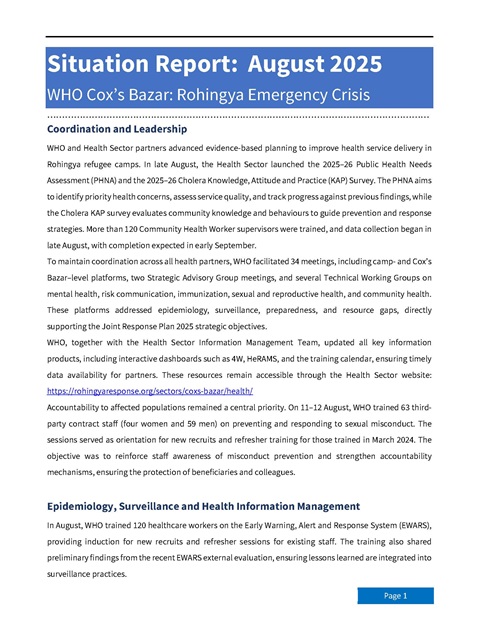WHO Cox’s Bazar: Rohingya emergency crisis - Situation Report: August 2025
Situation report

Overview
Coordination and Leadership
WHO and Health Sector partners advanced evidence-based planning to improve health service delivery in Rohingya refugee camps. In late August, the Health Sector launched the 2025–26 Public Health Needs Assessment (PHNA) and the 2025–26 Cholera Knowledge, Attitude and Practice (KAP) Survey. The PHNA aims to identify priority health concerns, assess service quality, and track progress against previous findings, while the Cholera KAP survey evaluates community knowledge and behaviours to guide prevention and response strategies. More than 120 Community Health Worker supervisors were trained, and data collection began in late August, with completion expected in early September.
To maintain coordination across all health partners, WHO facilitated 34 meetings, including camp- and Cox’s Bazar–level platforms, two Strategic Advisory Group meetings, and several Technical Working Groups on mental health, risk communication, immunization, sexual and reproductive health, and community health. These platforms addressed epidemiology, surveillance, preparedness, and resource gaps, directly supporting the Joint Response Plan 2025 strategic objectives.
WHO, together with the Health Sector Information Management Team, updated all key information products, including interactive dashboards such as 4W, HeRAMS, and the training calendar, ensuring timely data availability for partners. These resources remain accessible through the Health Sector website: https://rohingyaresponse.org/sectors/coxs-bazar/health/
Accountability to affected populations remained a central priority. On 11–12 August, WHO trained 63 third-party contract staff (four women and 59 men) on preventing and responding to sexual misconduct. The sessions served as orientation for new recruits and refresher training for those trained in March 2024. The objective was to reinforce staff awareness of misconduct prevention and strengthen accountability mechanisms, ensuring the protection of beneficiaries and colleagues.
